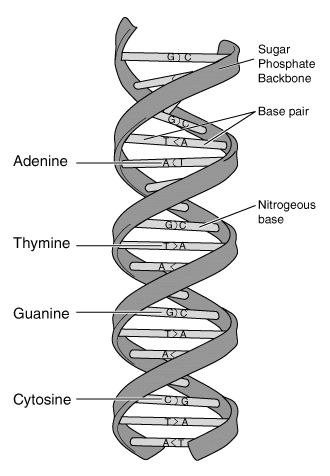Frequently Asked Questions > FAQ's about Genetics > What is a Chromosome?
Search the FAQ for entries containing:
What is a chromosome? In order to answer this question in more detail, we must talk about how the human body is organized. The human body is made up of organs, such as the skin, heart, brain and liver. The organs are made up of tissues such as adipose and connective tissues. The tissues are made up of cells. Each cell contains a set of 46 chromosomes. Contained on those chromosomes are the genes, which are the specific instructions that tell the body how to grow and develop.
In a way, chromosomes are very similar to a cookbook. The chapters represent the chromosomes. Each gene is a recipe that gives the body an instruction.
Because different cells in the body perform different tasks, different genes are activated in each of the cells. Again, we can use the example of the cookbook. You and all of your friends may have the same cookbook, but you each use different recipes from the book. This cookbook may have all the recipes that anyone could ever want, but you use a small number of recipes over and over. You use different recipes from those of your friends because you are different people with different needs and preferences. In this example, you and your friends are like the cells of the body, each one using the recipes (genes) you need to function and grow.
The cookbook example is not accurate in one important way. In a cookbook the recipes are organized into chapters. For example, one chapter might be on desserts and another chapter is on vegetable dishes. The chromosomes are not in an obvious biological order, and the genes contained on a chromosome are not grouped in a way that would make sense to us. For example, all the genes for making an arm are not together on the same chromosome. In fact, all the genes for making bones are not grouped together either. Although this does not fit into our rationale for organization, the cells of the body seem to have no trouble with it.
What are Chromosomes Actually Made of?
A chromosome, and therefore the genes that are on the chromosome, is made of a chemical called deoxyribonucleic acid, or DNA. The DNA is composed of four chemical components called bases. The four bases are adenine, thymine, cytosine, and guanine. These components are symbolized by using one of 4 letters (A, T, C, or G).
DNA is made of two strands, each composed of a long string of the A’s, T’s, C’s, and G’s. The two strands run parallel to one another. In fact, the structure of DNA is often described as a twisted ladder. To create the ladder’s rungs, each of the bases on one strand is paired to a base on the other strand. These rungs are called the basepairs. A always pairs with T, and C always pairs with G.

How do the genes tell the body what to do?
Essentially, genes tell the cells how to create proteins. Proteins are long strings of smaller molecules known as amino acids. Proteins have a large number of functions, from helping to hold cells and tissues together to digesting food.
Each group of 3 DNA bases tells the cell which amino acid to add to the protein. Thus, a long string of As, Ts, Cs, and Gs can be "read" by the cell in groups of three and be translated into a protein. The cell only reads one side of the DNA ladder to make a protein.
“The above information is from the Chromosome 18 Registry & Research Society and was reproduced with permission.” Some minor changes have been made to make the information as applicable as possible to 1p36 Deletion Syndrome.


